This website uses cookies to offer you certain services and to enhance your user experience. By continuing to use our website, you consent to the usage of cookies as described in our Cookie Policy.
This website uses cookies to offer you certain services and to enhance your user experience. By continuing to use our website, you consent to the usage of cookies as described in our Cookie Policy.
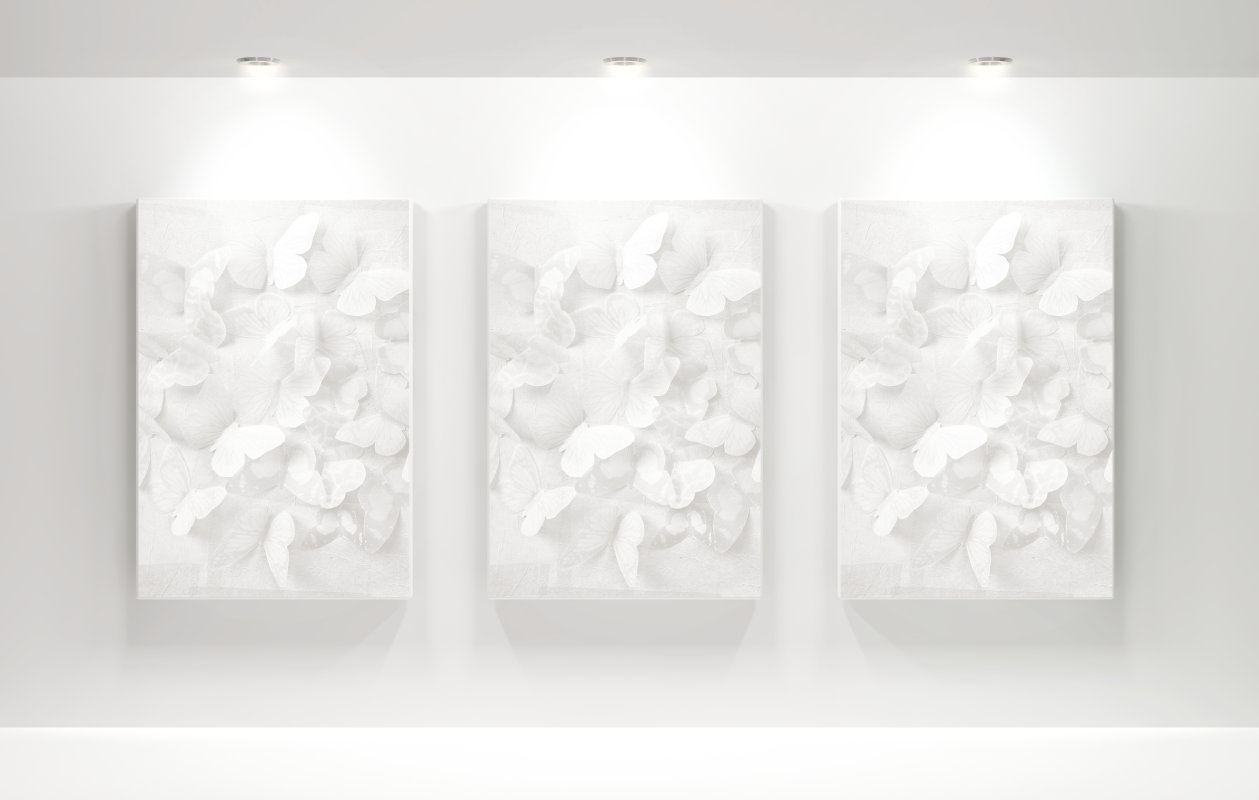
Superb Color Consistency with TENº binning
TENº binning addresses color consistency by adding a more representative CIE 2015 10° Observer Color Binning Scheme to the industry standard CIE 1931 2° color space. This breakthrough is necessary to cater for the typical general lighting applications where color consistency is judged under a 10° field of view rather than a 2°.
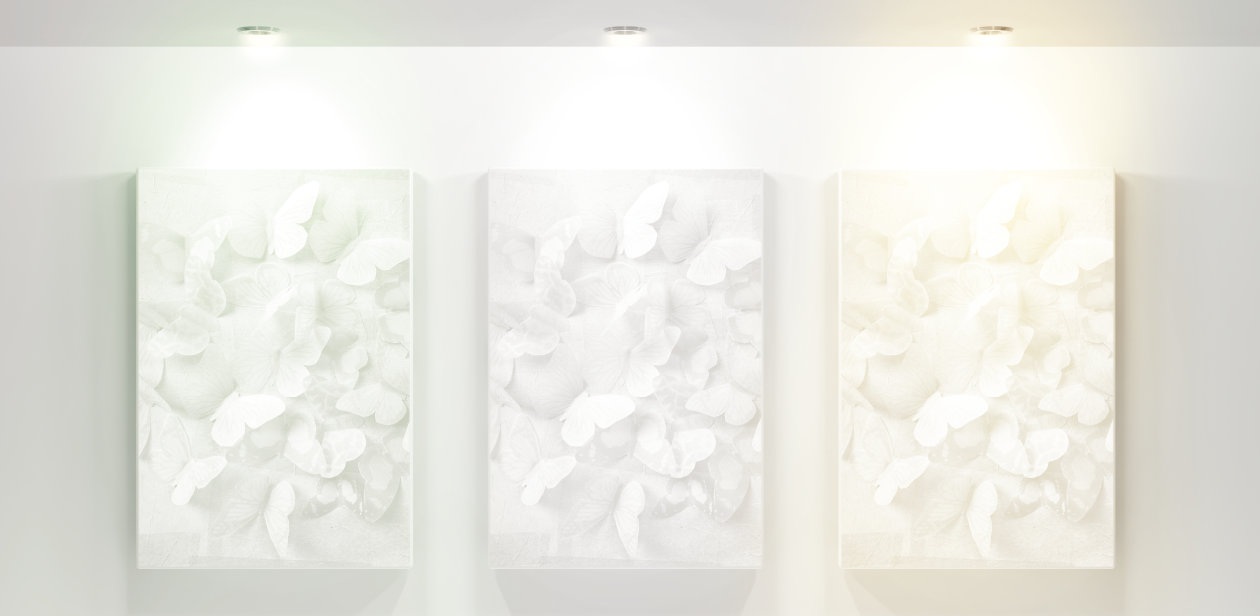
Imagine you are illuminating a scene with three spotlights. The white light from these three spotlights may look a bit different. You are measuring the color coordinates and they are not only within 1SDCM but they are exactly the same still they look different! How can this happen?
This problem is caused by some inaccuracies in the CIE 1931 2° xy color diagram which everyone is using right now for LED white binning. It may happen, that LEDs with different spectral composition may be measured to have exactly the same color coordinates but the visual perception still shows color differences! This spectral differences can be caused by different wavelengths of the blue chip or the converter compositions.
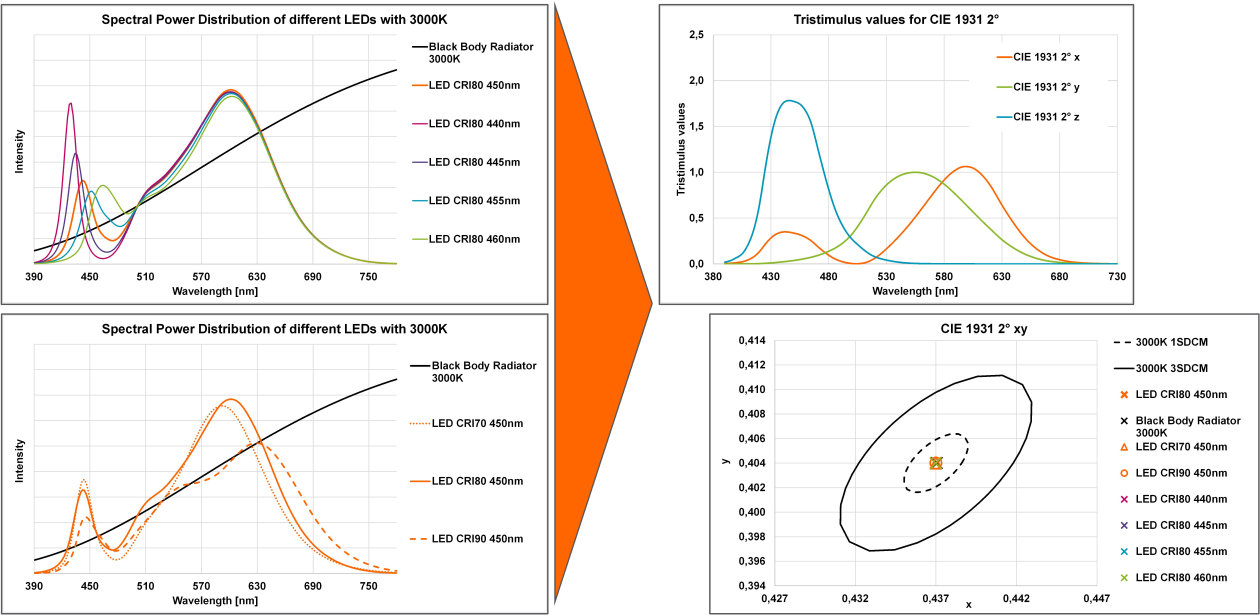
How can we solve this problem and measure more accurately the visual impression of color differences? With the introduction of TENº binning we are also applying the recent CIE 170-2:2015 technical report to LED binning. This report is using the latest cone fundamentals from 2006 to create a fundamental chromaticity diagram with physiological axes to ensure that the visible color differences are also captured in the measurement and binning accordingly! The new color matching functions are now summarizing 85 years of research.
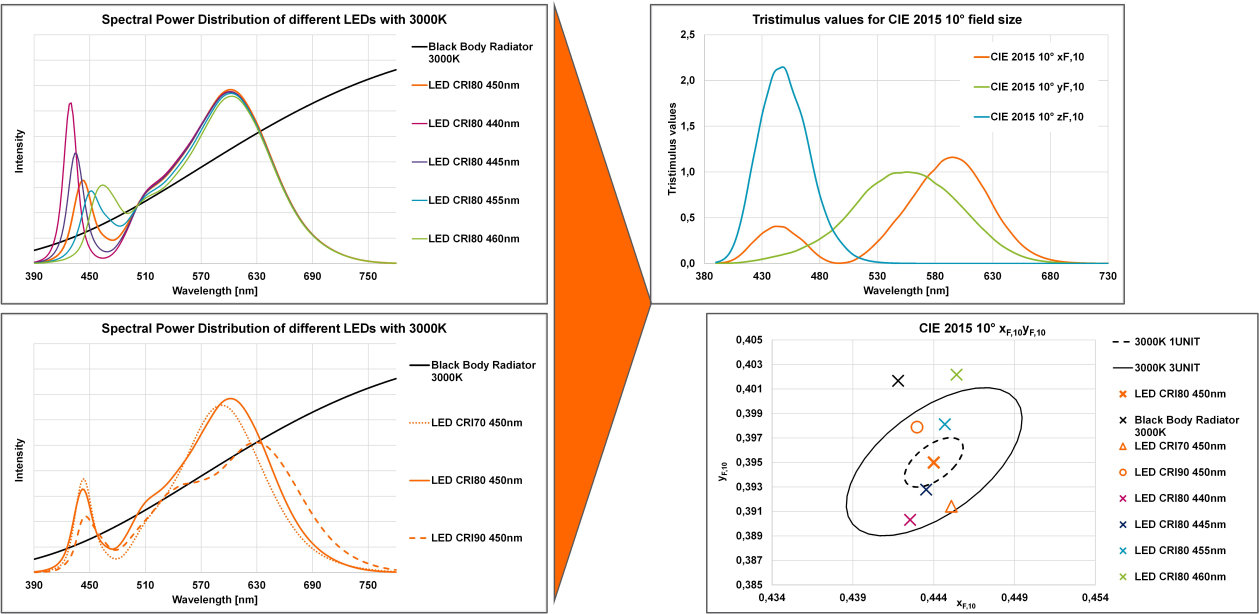
What exactly is the new OSRAM Opto Semiconductors TENº binning? The introduction of the new TENº binning is implementing three important and innovative steps to the white binning of LEDs to ensure that a 3SDCM binning really only shows up to 3UNIT real color differences and not more!

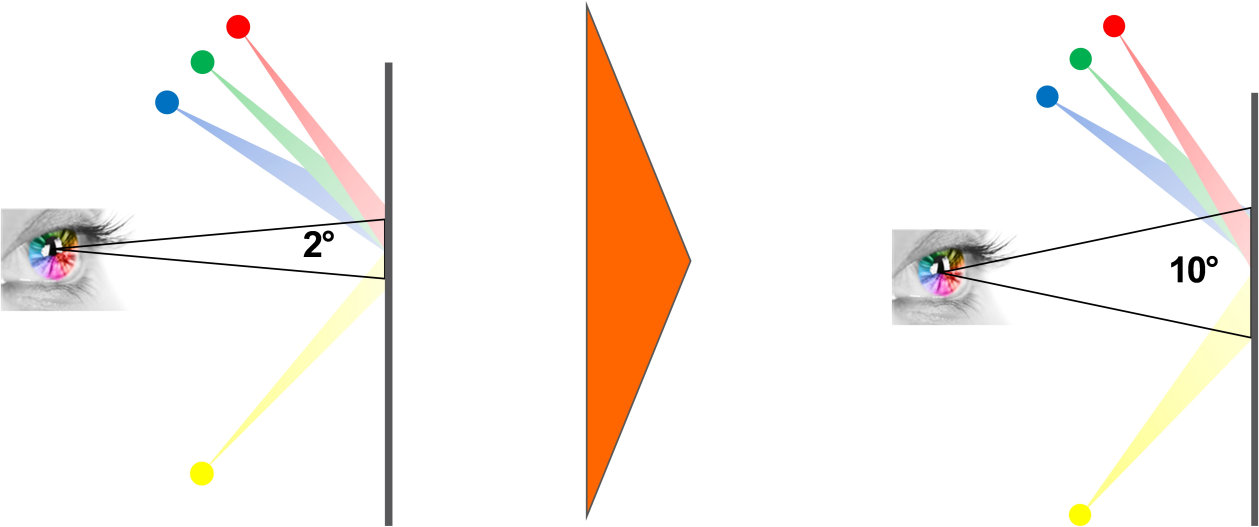

How will the luminaire manufacturer benefit from the TENº binning? The following simulated production distribution of white LEDs demonstrates the risk with a 1SDCM binning and the solution with TENº binning.
(Simulation parameters: CCT=4000K; CRI=80; blue wavelength variation=15nm)
We are using two sets of LEDs. One is binned in a tight 1SDCM binning. The other one comes in the “TENº binning”.
The 1SDCM binning looks very narrow and suggests a very small color discrepancy. The TEN° binning is a standard 3SDCM binning in the 1931 2° color diagram fulfilling all industry standards.
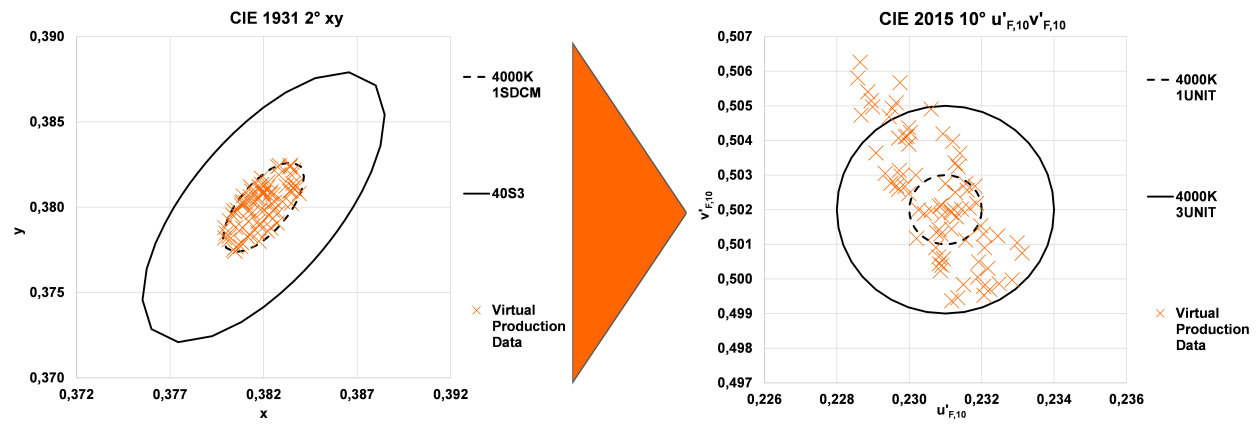
As we learned, the 1931 2° color space is not able to measure color differences correctly and it may happen that LEDs with a very small color difference in the old color space still have a very large color difference in the 2015 10°.
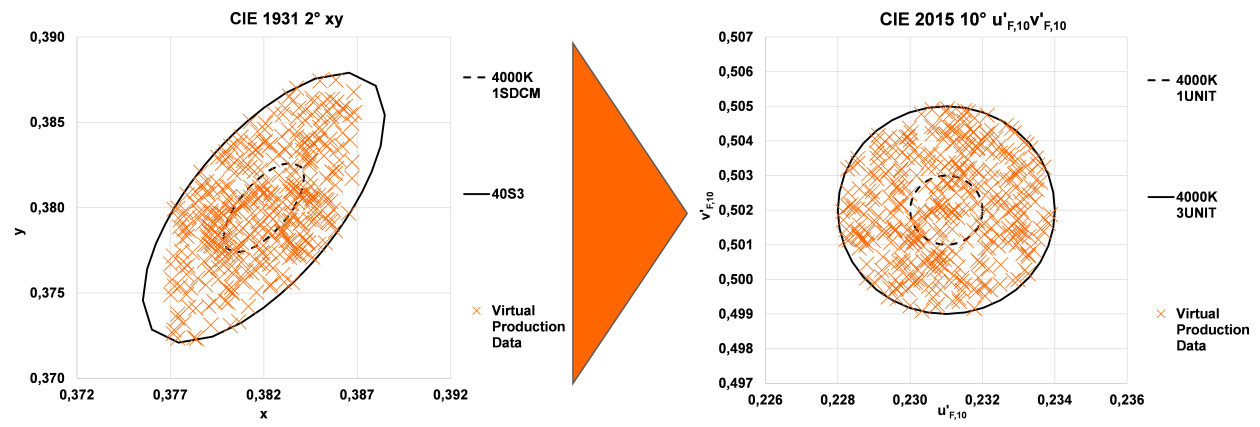
If the LEDs are measured in the 2015 10° color space, the 1SDCM binning widens significantly and shows color differences even more than 3UNITs! The TEN° binned LEDs are safely within the 3UNITs boundary and don’t lead to this kind of unpleasant surprises.
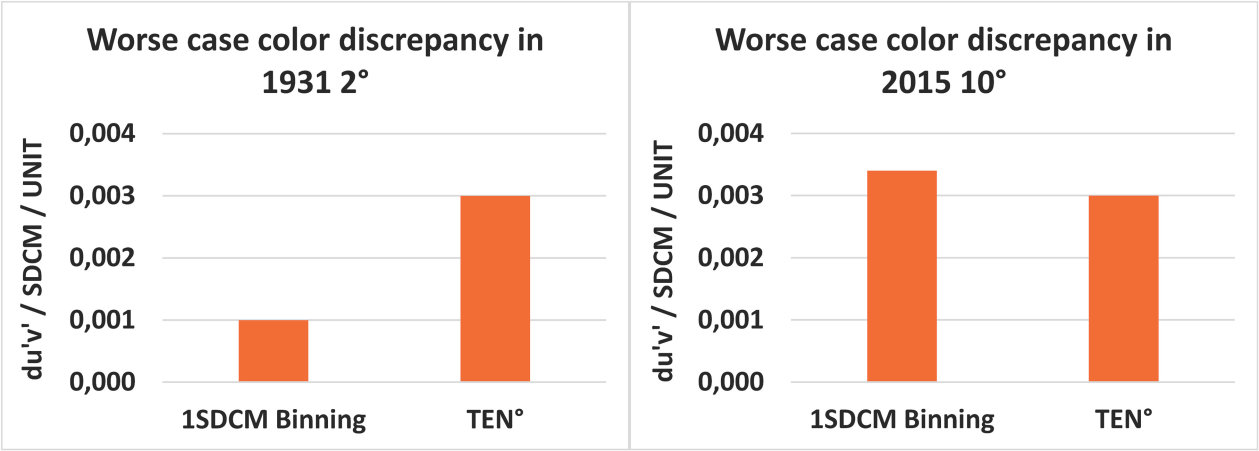
Therefore the TEN° Binning is outperforming even a 1SDCM when it comes to color differences induced by a large variation of spectral differences!
The new TEN° Binning will completely comply with the existing 1931 2° standard 3SDCM binning and can fulfill all requirements of existing designs and standards. The new 2015° 10° 3UNIT feature is an addition to provide a better protection against unexpected large color differences!
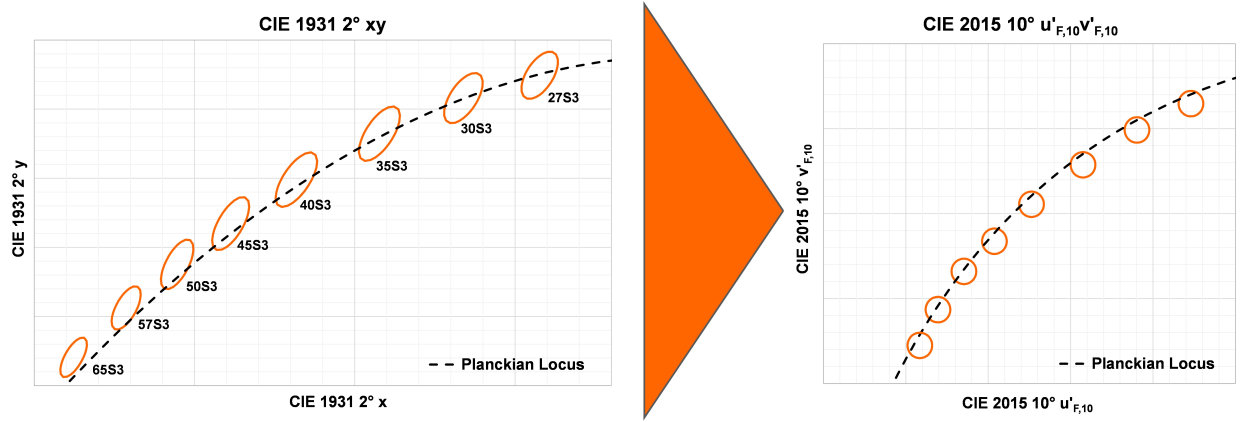
The luminaires will have significantly lower risk of looking different in color. We are using the latest and scientific proven color space for measurement and binning. This ensures the lowest possible color differences based on field of view. This will reduce the discussion with their customers and also the amount of rejects and rework in the field.
Imagine you are looking on a wall illuminated by a set of spot lights. Now place your thumb over the area you are observing and put your arm straight. The area covered by your thumb is roughly equivalent to a 2° observer / field of view. This is quite a small area, isn’t it? Now open your hand and the area your hand covers is equivalent to a 10° observer / field of view. This is much closer to reality and most applications.
Because the blue, green and red sensor cells / cones in our eye are not evenly distributed across the field of view. In the very center there is even an area without blue sensors at all. This leads to different color perceptions at different field of views.
No, the since TEN° is only an additional feature it does not change the existing Q-Number.
Yes please contact our Sales force.
As compatible as we are now. There is no competitor with a 10° binning at this point of time. If the standard 1931 2° binning is the same we are completely compatible and offer the TEN° binning as an addition feature to further improve color consistency.
No, the TEN° binning focusses on the color consistency between two LEDs, not the absolute position of the LEDs in the color space.
No, the TEN° binning focusses on the color consistency between two LEDs, based on the luminous flux measurement. The color over angle variation is good as it is right now.
This depends on the adoption speed of the market.
Bartenbach GmbH:
„Forschungsarbeiten bei Bartenbach zeigten, dass in manchen Fällen die klassische photometrische Bewertung des Lichtspektrums mit dem visuellen Erscheinungsbild nicht übereinstimmt. Diese Differenz wurde auch in Lichtplanungsprojekten mit hohen Ansprüchen an die spektrale Lichtqualität sichtbar. Osram setzt mit einem neuen Weißbinning den richtigen Schritt, um die Qualität einer Beleuchtungsanlage mit LEDs zu erhöhen.“
NEL Neontechnik Elektroanlagen Leipzig GmbH, Dr. rer.nat. R. Hennig, Diplomphysiker, Bereichsleiter F/E/A:
„Ich kann mich hier nur der Meinung des Institutes Bartenbach anschließen. Als Wissenschaftler bin ich der Meinung TEN° binning ist ein vollkommen richtiger Schritt in die richtige Richtung und ist bereits lange erwartet und notwendig. Ich hoffe sehr, dass der General Lighting Markt diesen Ansatz entsprechend honoriert und sich daraus ein neuer Standard etabliert.“



